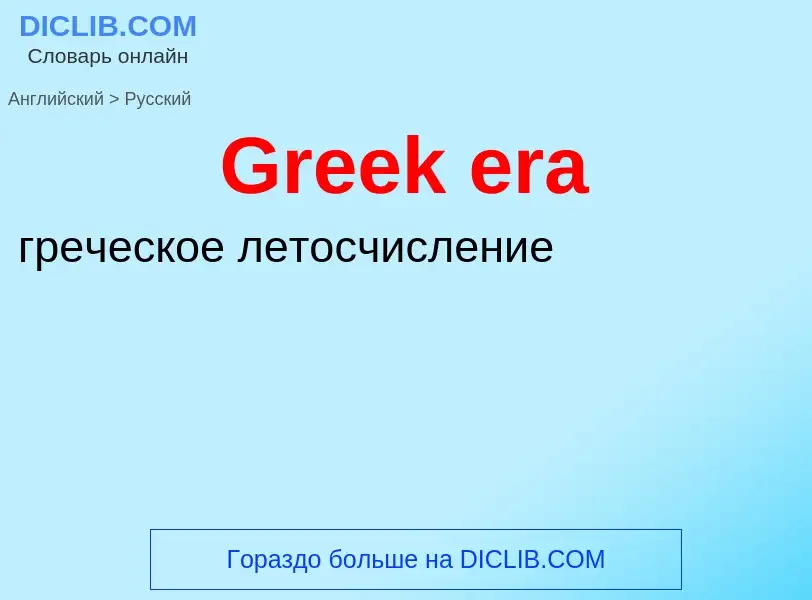Перевод и анализ слов искусственным интеллектом ChatGPT
На этой странице Вы можете получить подробный анализ слова или словосочетания, произведенный с помощью лучшей на сегодняшний день технологии искусственного интеллекта:
- как употребляется слово
- частота употребления
- используется оно чаще в устной или письменной речи
- варианты перевода слова
- примеры употребления (несколько фраз с переводом)
- этимология
Greek era - перевод на русский
общая лексика
греческая буква
Определение
Википедия
.jpg?width=120)
Ancient Greece (Greek: Ἑλλάς, romanized: Hellás) was a northeastern Mediterranean civilization, existing from the Greek Dark Ages of the 12th–9th centuries BC to the end of classical antiquity (c. 600 AD), that comprised a loose collection of culturally and linguistically related city-states and other territories. Most of these regions were officially unified only once, for 13 years, under Alexander the Great's empire from 336 to 323 BC (though this excludes a number of Greek city-states free from Alexander's jurisdiction in the western Mediterranean, around the Black Sea, Cyprus, and Cyrenaica). In Western history, the era of classical antiquity was immediately followed by the Early Middle Ages and the Byzantine period.
Roughly three centuries after the Late Bronze Age collapse of Mycenaean Greece, Greek urban poleis began to form in the 8th century BC, ushering in the Archaic period and the colonization of the Mediterranean Basin. This was followed by the age of Classical Greece, from the Greco-Persian Wars to the 5th to 4th centuries BC, and which included the Golden Age of Athens. The conquests of Alexander the Great of Macedon spread Hellenistic civilization from the western Mediterranean to Central Asia. The Hellenistic period ended with the conquest of the eastern Mediterranean world by the Roman Republic, and the annexation of the Roman province of Macedonia in Roman Greece, and later the province of Achaea during the Roman Empire.
Classical Greek culture, especially philosophy, had a powerful influence on ancient Rome, which carried a version of it throughout the Mediterranean and much of Europe. For this reason, Classical Greece is generally considered the cradle of Western civilization, the seminal culture from which the modern West derives many of its founding archetypes and ideas in politics, philosophy, science, and art.

.jpg?width=200)
![The [[Antikythera mechanism]] was an [[analog computer]] from 150 to 100 BC designed to calculate the positions of astronomical objects. The [[Antikythera mechanism]] was an [[analog computer]] from 150 to 100 BC designed to calculate the positions of astronomical objects.](https://commons.wikimedia.org/wiki/Special:FilePath/0142 - Archaeological Museum, Athens - Antikythera mechanism - Photo by Giovanni Dall'Orto, Nov 11 2009.jpg?width=200)


![The carved busts of four ancient Greek philosophers, on display in the British Museum. From left to right: [[Socrates]], [[Antisthenes]], [[Chrysippus]], and [[Epicurus]]. The carved busts of four ancient Greek philosophers, on display in the British Museum. From left to right: [[Socrates]], [[Antisthenes]], [[Chrysippus]], and [[Epicurus]].](https://commons.wikimedia.org/wiki/Special:FilePath/British Museum - Four Greek philosophers.jpg?width=200)

![Rome]] (non-Greek)}}
The orange areas were often in dispute after 281 BC. The [[Attalid dynasty]] occupied some of this area. Not shown: [[Indo-Greek Kingdom]].
Rome]] (non-Greek)}}
The orange areas were often in dispute after 281 BC. The [[Attalid dynasty]] occupied some of this area. Not shown: [[Indo-Greek Kingdom]].](https://commons.wikimedia.org/wiki/Special:FilePath/Diadochen1.png?width=200)
![Athenian]] coin, depicting the head of [[Athena]] on the obverse and her owl on the reverse – 5th century BC Athenian]] coin, depicting the head of [[Athena]] on the obverse and her owl on the reverse – 5th century BC](https://commons.wikimedia.org/wiki/Special:FilePath/EarlyAthenianCoin.jpg?width=200)

![Greek [[hoplite]] and Persian warrior depicted fighting, on an ancient kylix, 5th century BC Greek [[hoplite]] and Persian warrior depicted fighting, on an ancient kylix, 5th century BC](https://commons.wikimedia.org/wiki/Special:FilePath/Greek-Persian duel.jpg?width=200)

![Sarpedon]] from the battlefield of [[Troy]]; detail from an Attic [[white-ground]] [[lekythos]], c. 440 BC Sarpedon]] from the battlefield of [[Troy]]; detail from an Attic [[white-ground]] [[lekythos]], c. 440 BC](https://commons.wikimedia.org/wiki/Special:FilePath/Hypnos Thanatos BM Vase D56 full.jpg?width=200)
![The ''[[Victorious Youth]]'' (c. 310 BC) is a rare, water-preserved [[bronze sculpture]] from ancient Greece. The ''[[Victorious Youth]]'' (c. 310 BC) is a rare, water-preserved [[bronze sculpture]] from ancient Greece.](https://commons.wikimedia.org/wiki/Special:FilePath/L'atleta di Fano.jpg?width=200)
![Law Code of Gortyn]], [[Crete]], fragment of the 11th column. Limestone, 5th century BC Law Code of Gortyn]], [[Crete]], fragment of the 11th column. Limestone, 5th century BC](https://commons.wikimedia.org/wiki/Special:FilePath/Law Code Gortyn Louvre Ma703.jpg?width=200)
![[[Mosaic]] from [[Pompeii]] depicting [[Plato]]'s academy [[Mosaic]] from [[Pompeii]] depicting [[Plato]]'s academy](https://commons.wikimedia.org/wiki/Special:FilePath/Plato's Academy mosaic from Pompeii.jpg?width=200)

![The [[ancient Theatre of Epidaurus]], 4th century BC The [[ancient Theatre of Epidaurus]], 4th century BC](https://commons.wikimedia.org/wiki/Special:FilePath/The great theater of Epidaurus, designed by Polykleitos the Younger in the 4th century BC, Sanctuary of Asklepeios at Epidaurus, Greece (14015010416).jpg?width=200)
![[[Mount Olympus]], home of the [[Twelve Olympians]] [[Mount Olympus]], home of the [[Twelve Olympians]]](https://commons.wikimedia.org/wiki/Special:FilePath/Θερμαικος με θεα τον Ολυμπο!.jpg?width=200)
![A 16th-century edition of the New Testament ([[Gospel of John]]), printed in a renaissance typeface by [[Claude Garamond]] A 16th-century edition of the New Testament ([[Gospel of John]]), printed in a renaissance typeface by [[Claude Garamond]]](https://commons.wikimedia.org/wiki/Special:FilePath/Gospel Estienne 1550.jpg?width=200)
![Early Greek alphabet on pottery in the [[National Archaeological Museum of Athens]] Early Greek alphabet on pottery in the [[National Archaeological Museum of Athens]]](https://commons.wikimedia.org/wiki/Special:FilePath/NAMA Alphabet grec.jpg?width=200)

![A page from the [[Codex Argenteus]], a 6th-century Bible manuscript in Gothic A page from the [[Codex Argenteus]], a 6th-century Bible manuscript in Gothic](https://commons.wikimedia.org/wiki/Special:FilePath/Wulfila bibel.jpg?width=200)
